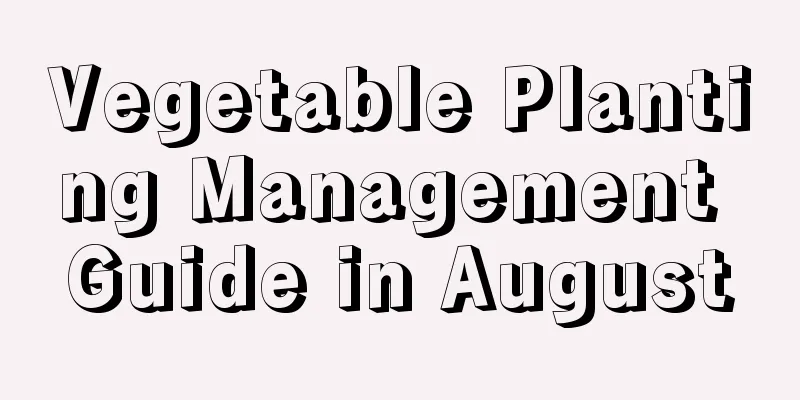Vegetable Planting Management Guide in August

|
August is the busy season for autumn vegetable sowing, seedling raising, planting and field management, but the hot and rainy climate in August poses challenges to the growth of vegetables and also brings the risk of high incidence of diseases and pests. So what should we pay attention to in vegetable planting management in August? Let’s learn more about it below. 1. Sowing and seedling raising According to local climatic conditions, choose suitable vegetable varieties for sowing or seedling raising. Vegetables that can be sown include leafy vegetables such as bok choy, Chinese cabbage, spinach, celery , as well as cauliflower, tomatoes, eggplants, etc. When raising seedlings, pay attention to preventing the seedlings from growing too fast and grasp the appropriate time for transplanting. 2. Moisture management The temperature is high in August and vegetables require a lot of water, so sufficient water supply should be ensured. But be careful to avoid overwatering as this may cause root rot. Water-saving irrigation methods such as drip irrigation and sprinkler irrigation can be used 3. Shade and cool down For cool-loving vegetables, such as lettuce and spinach, you can use a shade net to reduce the light intensity and avoid growth stagnation or yellowing caused by high temperature. If necessary, a spray system can be used to cool the vegetable leaves, replenish moisture on the leaves and alleviate heat damage. 4. Apply fertilizer at the right time In August, some vegetables, such as leafy vegetables, enter a rapid growth period and require timely top dressing and nutritional supplementation. It is recommended to use quick-acting nitrogen fertilizers, such as urea, but care should be taken to control the dosage to avoid excessive use that will cause vegetables to grow too tall. 5. Intertillage and weeding Carry out inter-row cultivation and weeding in time to keep the soil loose and well-ventilated. At the same time, soil can be cultivated in combination with intertillage to stabilize the plants and prevent lodging. 6. Pest and disease control After harvesting the previous crop of vegetables, it is necessary to clean up the dead branches and leaves in time and pay attention to the prevention and control of various diseases and pests. This includes downy mildew, soft rot, cabbage looper, fall armyworm, diamondback moth, etc. of vegetables such as melons, beans, cruciferous vegetables, tomatoes, peppers, eggplants and aquatic vegetables (such as water chestnuts and arrowheads) to ensure the health and yield of subsequent plantings. 7. Harvest in time Pay close attention to the maturity of vegetables and harvest them in a timely manner to avoid over-ripening and deterioration in quality. Vegetables that are usually suitable for harvesting in August include peppers, tomatoes, eggplants, cucumbers, amaranth, lettuce , leeks, lentils, cowpeas, etc. The above is the sharing of the fruit tree planting and management guide in August. Growers need to pay close attention to weather changes and flexibly adjust management measures to effectively respond to the challenges brought by high temperatures and heavy rains in August.
|
<<: Cabbage planting tips and methods
>>: What vegetables can be grown in August?
Recommend
The legend of Astragalus
Legend 1 A long time ago, during the Qing Dynasty...
The role and value of petunia
Decorate your home Petunia has the characteristic...
Fern cultivation methods and precautions
Ferns are relatively easy to grow. They originall...
How much is the yield of green beans per mu? What is the investment cost of planting green beans per mu?
Green beans yield per mu The yield per mu of gree...
Cultivation methods and precautions of Golden Edge Agave
Water and fertilizer requirements A mixture of le...
The reason why the tips of camellia leaves turn black and fall off
1. Low temperature Reason: Camellia prefers a war...
How to dry the leaves of purple calyx flower
1. The temperature is not suitable Generally, the...
Can Phalaenopsis be repotted in summer? Methods and precautions for repotting
Can Phalaenopsis be repotted in summer? Phalaenop...
What fertilizer can orchids use to bloom more? How to make homemade orchid fertilizer
1. What fertilizer to use Fertilizers such as pot...
How many years does it take for passion fruit trees to bear fruit?
Introduction to Planting Passion Fruit Trees The ...
Where do jasmine seeds come from?
Where do jasmine seeds come from? Jasmine is gene...
Why does azalea drop leaves? How to remedy it
1. Why does azalea drop leaves? 1. Excessive wate...
Don’t grow succulents, I’m serious!
Don’t grow succulents! Because after you start gr...
Which regions are suitable for the cultivation conditions of Phoebe nanmu?
Planting conditions of Phoebe nanmu 1. Suitable c...
What to do if the leaves of mountain rose turn yellow
Reasons why mountain rose leaves turn yellow The ...









